|
FAQs about Non-Vertebrate Animal Identification
63
Related Articles: Marine Invertebrates, Marine Invertebrate Systems, Marine Invertebrate Compatibility,
Marine Invertebrate Disease,
Marine Invertebrate
Reproduction, Quarantine of Corals and
Invertebrates, Feeding
Reef Invertebrates, Lighting
Marine Invertebrates,
Water
Flow, How Much is Enough,
Related FAQs: Non-Vert IDs 1, Non-Vert IDs 2, Non-Vert IDs 3, Non-Vert IDs 4, Non-Vert IDs 5, Non-Vert IDs 6, Non-Vert IDs 7, Non-Vert IDs 8, Non-Vert IDs 9, Non-Vert IDs 10, Non-Vert IDs 11, Non-Vert IDs 12, Non-Vert IDs 13, Non-Vert IDs 14, Non-Vert IDs 15, Non-Vert IDs 16, Non-Vert IDs 17, Non-Vert IDs 18, Non-Vert. ID 19, Non-Vert. ID 20, Non-Vert. ID 21, Non-Vert. ID 22, Non-Vert. ID 23, Non-Vert. ID 25, Non-Vert ID 26, Non-Vert ID 27, Non-Vert ID 28, Non-Vert ID 29, Non-Vert ID 30, Non-Vert ID 31, Non-Vert ID 32, Non-Vert 33, Non-Vert ID 34 Non-Vert ID 35, Non-Vert ID 36, Non-Vert ID 37, Non-Vert ID 38, Non-Vert ID 39, Non-Vert ID 40, Non-Vert ID 41, Non-Vert ID 42, Non-Vert ID 43, Non-Vert ID 44, Non-Vert ID 45, Non-Vert ID 46, Non-Vert ID 47, Non-Vert ID 48, Non-Vert ID 49, Non-Vert ID 50, Non-Vert ID 51, Non-Vert ID 52, Non-Vert ID 53, Non-Vert ID 54, Non-Vert ID 55,
Non-Vert ID 56, Non-Vert ID
57, Non-Vert ID 58,
Non-Vert ID 59,
Non-Vert ID 60,
Non-Vert ID 61,
Non-Vert ID 62, Non-Vert ID 64,
Non-Vert ID 65,
& Marine Invertebrates,
Marine Invert.s 2,
Marine Invert.s 3, & FAQs about:
Marine Invertebrate Behavior,
Marine Invertebrate
Compatibility, Marine
Invertebrate Selection, Marine
Invertebrate Systems, Feeding
Reef Invertebrates, Marine
Invertebrate Disease, Marine
Invertebrate Reproduction, &
& LR
Life Identification, LR Hitchhiker ID
1, Anemone Identification,
Aiptasia
Identification, Aiptasia ID 2,
Worm Identification, Tubeworm ID, Polychaete Identification, Snail Identification, Marine Crab
Identification, Marine Invert.s 1,
Marine Invert.s 2, Marine Plankton,
|
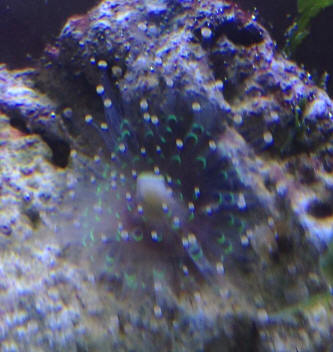 |
|
HH ID 2/2/16
Hi, I was hoping you could help me identify this hitchhiker. I bought a plug
rock with some purple death Zoas and apparently this was along with it. It
looks like a fat spotted worm of some sort and slowly inches along.
<? Where is this in your image?>
It has been in for about 3 days and I noticed what appeared to be a tuxedo
urchin on the rock. The supposed tuxedo urchin I cannot find and this little guy
showed up this morning.
Thanks in advance,
-Mike Lyons
<The greyish "space ship" shaped thing here? Either a colonial Ascidian or
sponge. Bob Fenner>
|

|
Re: HH ID 2/3/16
Thanks for the reply. I've attached another pic that's not zoomed in. The animal
in question is sitting directly on top of the crushed coral and has a gray body
color with some large black spots and some smaller yellowish/brown spots.
<Yes! This is what I thought... again, likely a Sea Squirt if not moving; a
Cuke/Holothuroidean if moving... See WWM re... evidence of good conditions here>
Behind it and to the left is one of my snails. It looks similar to a small sea
cucumber if I had to make a guess at what it
could be.
<If motile... does it show feeding apparatus at the present left end? BobF>
|
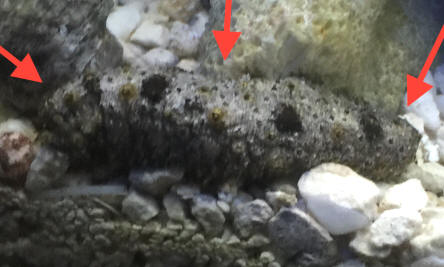 cropped, spiffed
cropped, spiffed |
|
|
ID please 1/14/16
Hello WWM. You're awesome. : )
<Hey Carmen!>
This nickel sized shell-less snail looking guy was cruising around on the bottom
of a holding plastic tub of Tampa bay Saltwater live rock. He is transparent,
beige/white in color. I can see a dark mass inside of him. He has suction and a
snout. He's cute. If he doesn't eat corals for fun I'd like to keep him. He's in
a party red cup while on trial.
<I see>
Where will I be able to see your reply?
<Mmm.... here and on WWM's dailies; parsed...>
Verdict?
<Well; I can't make out much detail... in trying to optimize your pic... to
discern whether this is actually a mollusc or a worm. I'd likely remove this
animal>
Thank you.
<Welcome. Bob Fenner>
|
.JPG)
.JPG) |
|
Jelly like substance. 1/11/16
Hello again! (Happy vacation Bob!)
<Thanks Kittie; just back from the restaurant here in Key Largo>
I am hoping that perhaps one of you other knowledgeable crew members might know
what this is and if I did right by removing this.
<Yes; a reproductive event. Not a problem>
This has happened twice in 1 - 1 1/2 months. The first time I noticed, in my
saltwater tank. this jelly like blob very close to what I believed was a
spaghetti worm cone,
<Yes>
I left it alone thinking egg sack but then several minnows got ensnared and
started to decompose. I removed that and today I noticed this on basically in
the same spot. I do have spaghetti and feather duster worms, which I enjoy
watching. Is this a sign of stress or hopefully happiness of the worms?
<More likely they are "happy">
Should I be worried?
<Mmm; no>
I have looked online and have been unable to find a match to the attached
photos. Any knowledge you have would be appreciated!
Sincerely,
Kittie
<This, these are Polychaete worm reproductive materials. I'd just net out and
remove. Bob Fenner>
|
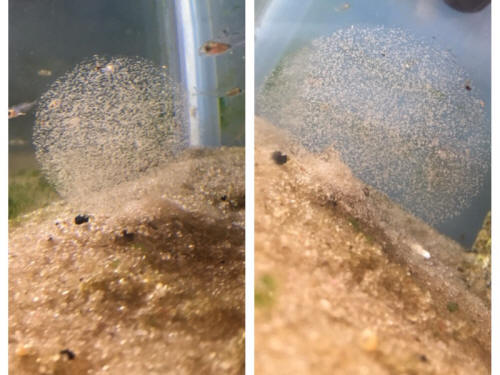 |
|
hitchhiker identification?
1/5/16
Hello Wet Web Media
I would appreciate some help in identifying this hitchhiker on the base of a
small golden torch
These photos were taken about a month apart. The first one is the most recent.
[image: Inline image 1]a s
Thanks!
Kelly Crowe
<Appears to be a Prosobranch Gastropod (snail) of some sort.... the Serpulid
(poss.) snails having settled on its translucent shell... I would remove these
and their egg casings if you find them; for general purpose.
Bob Fenner>
|
 |
|
Found this on the beach 12/20/15
Hey crew, I found the shell on a beach (Port Elizabeth, South Africa) I believe
it to be an isopod, just need to know. Never saw something like it before
<Nope, not an isopod crustacean but in fact a Chiton, a mollusc and a member of
the class Polyplacophora. Fascinating creatures from an evolutionary line quite
distinct from the "higher" molluscs (gastropods, bivalves, scaphopods and
cephalopods) and retaining many primitive features, not least of which is the
segmented shell. They are actually very common and widespread, but because they
are nocturnal in habit and tend to avoid light they are not always obvious. Turn
over rocks and seaweed to find them. Cheers, Neale.>
|
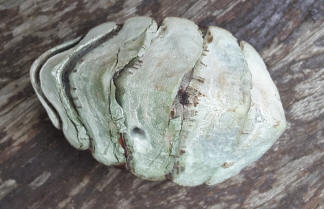
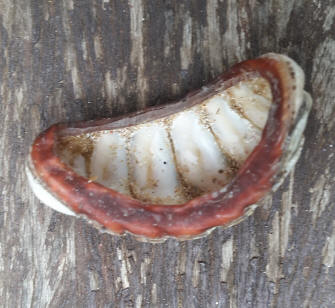 |
Mysterious Life Form /Earl 12/12/15
<Movie HERE:>
Hello Crew!
<Oh wow! I have never seen these but they are amazing, they swim like little
cephalopods. Bob?? -Earl>
Mysterious Life Form /RMF
Hello Crew!
<Bob>
I look to you guys as the best and so I hope that you can help me solve my
little mystery.
<Ok>
I have attached a short video of an invasive life form. At first glance, it
would appear to be some sort of Aiptasia because they are fairly translucent,
but that’s about the only resemblance. I have no idea what it could be. I’m
hoping you know what it is and what I can do to get rid of it.
<At first I thought this too was some species of free-living (and swimming)
Actinarian/Anemone; some sort of weird strobilized Medusoid scyphozoan?... but
the taper of its "legs"/appendages, appearance of some sort of bulbous
head-appearing part of the body in its apparent center, motion from this
point... are reminiscent of a Cephalopod.... am guessing this is an octopus,
squid.... >
This growth does not shrink away from the touch. It does not hide. It does not
appear to attack the corals, or fish. The corals continue to grow.
It does proliferate quickly. It has spread throughout my tank and into my
refugium.
My fish and corals are growing happily. But these little “things” are irritating
to me in that they are everywhere: on the glass, on the sand, on the rocks, on
the snails, the jet pumps, the thermometer, etc. You get the idea. You’ll see in
the video that it actually has a swimming motion. Its arms move. But, once it
find a place to land. It pretty much remains there. The fish will not eat them.
<Oh, this IS an important clue. As far as I'm aware, all cephalopod young are
palatable to fishes>
They measure approximately 1/2 centimeter. I have been to 2 LFS stores in hopes
of getting some idea to eradicate them from the aquarium. But, no one seems to
know what they are. One store suggested a File Fish might work.
<Mmm; may be>
Background: I always quarantine everything before putting it into the tank.
Somehow this sneaked in. I do not know how. It obviously slipped in on
something.
<Yes; something "hard", like live rock or a bit of same that a stony coral or
such was attached to. The thing is, the eggs of cephalopods are quite large;
likely you'd have seen them>
I’m wondering if it could have made it’s way in during a water change.
Regardless, the tank is a 55 gallon tank. There is a 20 gallon refugium.
Parameters are acceptable. Nitrates are high, but working to lower them. None of
my fish have ever been in ill-health. I have never had the dreaded Ich. I have
been a reefer for 8 years, but do not consider myself an expert. The Fish
inhabitants include: a Powder Brown Tang, Yellow Tang, Yellow-Tail Damsel, 2
False Percula Clown Fish, a Banggai Cardinal, a Watchman Goby and Pistol Shrimp.
Also, various snails and crabs.
What can I do to rid my tank of these little pests?
<I think/fear just netting them out...>
Thank you,
-Bob
<Thank you for sharing. Bob Fenner>
|
Sand Critter ID 10/16/15
Hello Crew,
Please help me identify the critter centered in the top half of the pictures.
<....?>
About two weeks ago I noticed this thing in my sand. From tentacle(?) to
tentacle it is about the size of a dime. It looks like spider legs coming out of
a hiding hole. Or it looks like that creature in Star Wars that they try to
throw Han Solo into it.
<Heeeee! "Go w/ the force Luke">
Half the tentacles look white and the others brownish. The center looks black,
and is below the surface level. I can't tell how far it goes down. So, it looks
like a little hole with tentacles sticking out that lay flat on the sand and I
never see it move.
What is it???
Much Thanks.
<Likely an anemone or worm of some sort. See WWM and send along a better
resolved pic when you can. Bob Fenner>
|

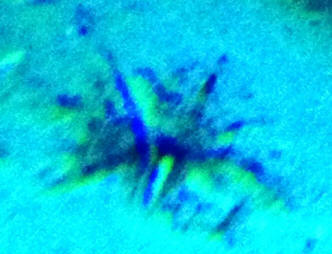 crop
crop |
|
Re: Sand Critter ID 10/16/15
Thanks for taking the time. I took these new pictures this morning while the
tank was still dark. They are not good pictures with that lighting, but you can
see it now extended above the surface. When I first shined the light it was
elevated slightly more than that. Can you tell anymore from these pictures?
<Same answer. Still too poorly resolved. B>
I can't seem to find it on your site.
<Try a different camera, lens?>
Thanks,
Nick
|
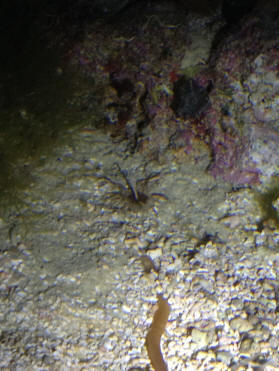
%20%20fcrop.jpg) crop...
crop...
|
Re: Sand Critter ID 10/20/15
Bob,
One last attempt at a pic.
<Still no good>
When I tried to scoop it out with a net, it quickly disappeared into the sand.
<Oh; a good clue; still same guesses; but more likely a type of Anemone... a
Cerianthid....?>
I scooped out about 2" of sand and it apparently had retracted deeper than that.
It was very fast. It is back now. It is too fast for me to get it with a net, so
I need to find some kind of cup or scoop that I can move quickly into the sand.
I'm going to try to feed it tonight to see what it's reaction is, which might
help with identification.
Sorry to waste your time with bad photos. Hoping this is sufficient.
Nick
<Cheers, Bob Fenner>
|
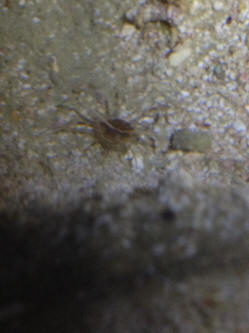
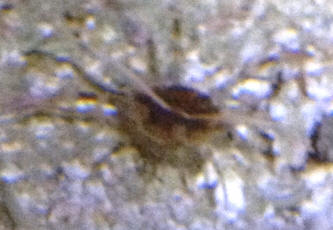 crop
crop |
|
|
Strange growth? 10/11/15
Hello there. Just want to firstly thank you for the wealth of information you
share here. You are my number one spot to research everything. Now, for my
question. I have a 55 gallon salt water tank that has a cluster of mussels (no
longer living) which I collected from the ocean (Atlantic coast
southeast Florida).
<Ahh!>
There is a very strange, but beautiful growth spreading slowly on it and I'm not
even sure what to search to try and identify it. Could you help?
<Yes; this is a colonial Ascidian... the "Flat Tunicate", Botrylloides nigrum >
The picture is taken close up, the grow is about the size of a dime currently.
Any help would be greatly appreciated. Thank you!
<Cheers, Bob Fenner>
|
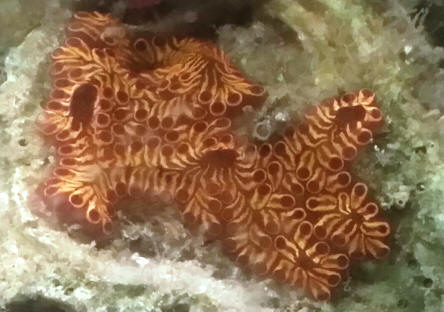
Strange growth? 10/12/15
Thank you so much!
<Ah welcome. Thank you for sharing. BobF>
|
|
Hitchhiker IDs 8/15/15
Hello.
<Sarah>
I am needing an identification on two hitch-hikers that have made their way into
my tank.
The anemone? looking thing appears to be multiplying.
There is a smaller one beside it now. I am wondering if this IS an anemone or
some other type of coral that resembles an anemone?
<Mmm; yes; appears to be a Pseudocorynactis... a Corallimorpharian.... can be
trouble... stinging other life. Most folks treat as a pest and remove them. See
WWM Re>
It is clear with white bulbs on the ends of its fingers with a green inner
“core”. Its “mouth” area is different than any anemone I’ve ever seen. Can you
help with an ID for it? I’m most interested if it will harm my seahorses. This
is in a hippocampus erectus tank.
<Will eat your Horses in time>
The second thing is (only one picture) is pink and has pores like there will be
polyps that will come out of it. It is soft but has an underlying structure.
<Mmmm>
This has only been in my tank 24 hours now. I am wondering if this is some sort
of toadstool? It goes down to a V shape that I glued to a small rock then buried
it in the sand.
<Is this... a Renilla?>
Thanks,
Sarah
<Welcome. Bob Fenner>
|

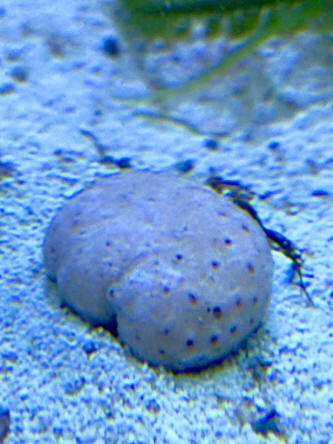 |
|
|

